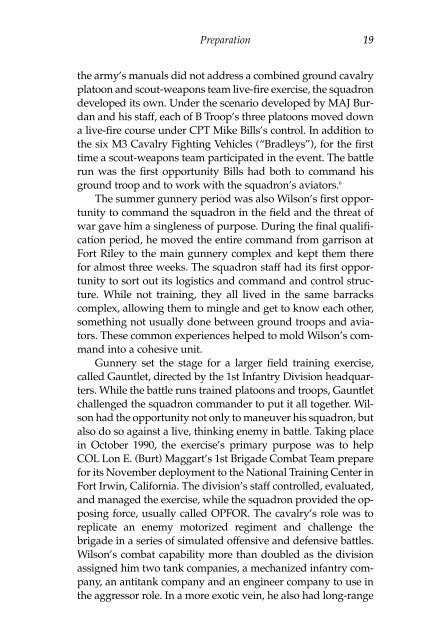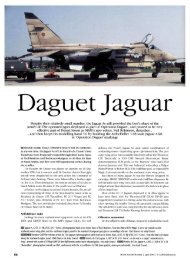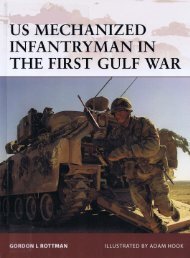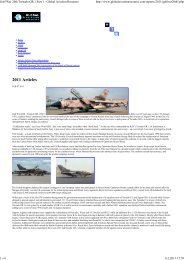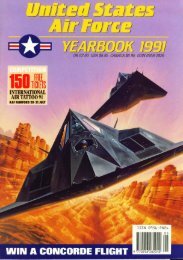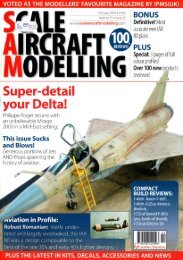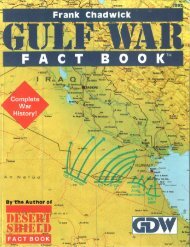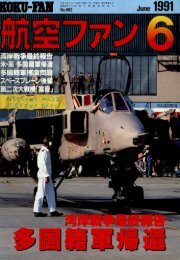The Road to Safwan: The 1st Squadron, 4th Cavalry in the 1991 ...
The Road to Safwan: The 1st Squadron, 4th Cavalry in the 1991 ...
The Road to Safwan: The 1st Squadron, 4th Cavalry in the 1991 ...
You also want an ePaper? Increase the reach of your titles
YUMPU automatically turns print PDFs into web optimized ePapers that Google loves.
Preparation 19<br />
<strong>the</strong> army’s manuals did not address a comb<strong>in</strong>ed ground cavalry<br />
pla<strong>to</strong>on and scout-weapons team live-fire exercise, <strong>the</strong> squadron<br />
developed its own. Under <strong>the</strong> scenario developed by MAJ Burdan<br />
and his staff, each of B Troop’s three pla<strong>to</strong>ons moved down<br />
a live-fire course under CPT Mike Bills’s control. In addition <strong>to</strong><br />
<strong>the</strong> six M3 <strong>Cavalry</strong> Fight<strong>in</strong>g Vehicles (“Bradleys”), for <strong>the</strong> first<br />
time a scout-weapons team participated <strong>in</strong> <strong>the</strong> event. <strong>The</strong> battle<br />
run was <strong>the</strong> first opportunity Bills had both <strong>to</strong> command his<br />
ground troop and <strong>to</strong> work with <strong>the</strong> squadron’s avia<strong>to</strong>rs. 6<br />
<strong>The</strong> summer gunnery period was also Wilson’s first opportunity<br />
<strong>to</strong> command <strong>the</strong> squadron <strong>in</strong> <strong>the</strong> field and <strong>the</strong> threat of<br />
war gave him a s<strong>in</strong>gleness of purpose. Dur<strong>in</strong>g <strong>the</strong> f<strong>in</strong>al qualification<br />
period, he moved <strong>the</strong> entire command from garrison at<br />
Fort Riley <strong>to</strong> <strong>the</strong> ma<strong>in</strong> gunnery complex and kept <strong>the</strong>m <strong>the</strong>re<br />
for almost three weeks. <strong>The</strong> squadron staff had its first opportunity<br />
<strong>to</strong> sort out its logistics and command and control structure.<br />
While not tra<strong>in</strong><strong>in</strong>g, <strong>the</strong>y all lived <strong>in</strong> <strong>the</strong> same barracks<br />
complex, allow<strong>in</strong>g <strong>the</strong>m <strong>to</strong> m<strong>in</strong>gle and get <strong>to</strong> know each o<strong>the</strong>r,<br />
someth<strong>in</strong>g not usually done between ground troops and avia<strong>to</strong>rs.<br />
<strong>The</strong>se common experiences helped <strong>to</strong> mold Wilson’s command<br />
<strong>in</strong><strong>to</strong> a cohesive unit.<br />
Gunnery set <strong>the</strong> stage for a larger field tra<strong>in</strong><strong>in</strong>g exercise,<br />
called Gauntlet, directed by <strong>the</strong> <strong>1st</strong> Infantry Division headquarters.<br />
While <strong>the</strong> battle runs tra<strong>in</strong>ed pla<strong>to</strong>ons and troops, Gauntlet<br />
challenged <strong>the</strong> squadron commander <strong>to</strong> put it all <strong>to</strong>ge<strong>the</strong>r. Wilson<br />
had <strong>the</strong> opportunity not only <strong>to</strong> maneuver his squadron, but<br />
also do so aga<strong>in</strong>st a live, th<strong>in</strong>k<strong>in</strong>g enemy <strong>in</strong> battle. Tak<strong>in</strong>g place<br />
<strong>in</strong> Oc<strong>to</strong>ber 1990, <strong>the</strong> exercise’s primary purpose was <strong>to</strong> help<br />
COL Lon E. (Burt) Maggart’s <strong>1st</strong> Brigade Combat Team prepare<br />
for its November deployment <strong>to</strong> <strong>the</strong> National Tra<strong>in</strong><strong>in</strong>g Center <strong>in</strong><br />
Fort Irw<strong>in</strong>, California. <strong>The</strong> division’s staff controlled, evaluated,<br />
and managed <strong>the</strong> exercise, while <strong>the</strong> squadron provided <strong>the</strong> oppos<strong>in</strong>g<br />
force, usually called OPFOR. <strong>The</strong> cavalry’s role was <strong>to</strong><br />
replicate an enemy mo<strong>to</strong>rized regiment and challenge <strong>the</strong><br />
brigade <strong>in</strong> a series of simulated offensive and defensive battles.<br />
Wilson’s combat capability more than doubled as <strong>the</strong> division<br />
assigned him two tank companies, a mechanized <strong>in</strong>fantry company,<br />
an antitank company and an eng<strong>in</strong>eer company <strong>to</strong> use <strong>in</strong><br />
<strong>the</strong> aggressor role. In a more exotic ve<strong>in</strong>, he also had long-range


